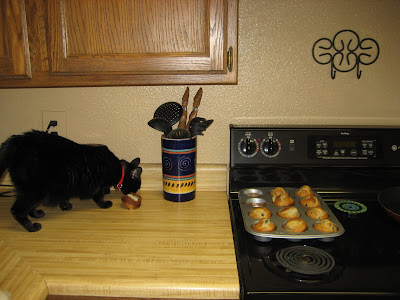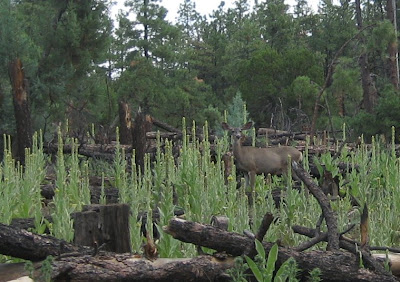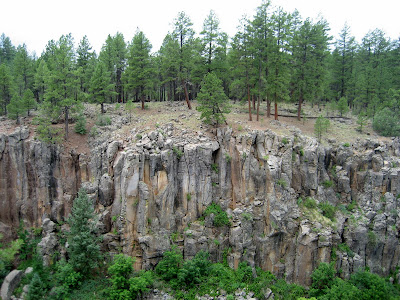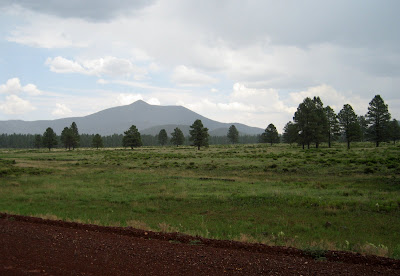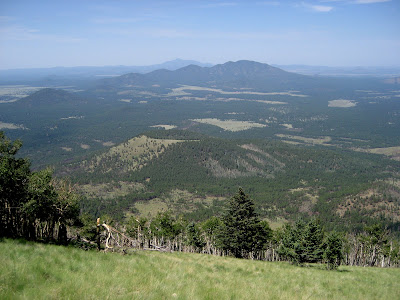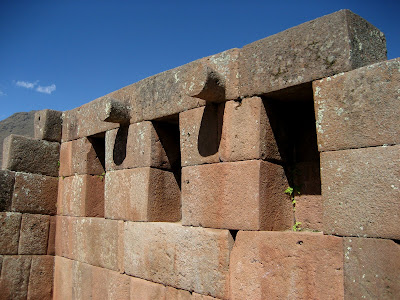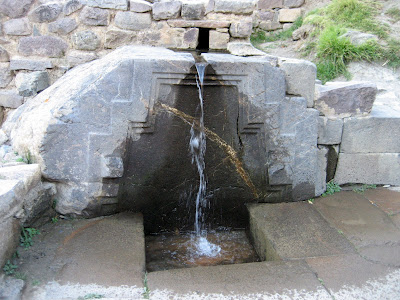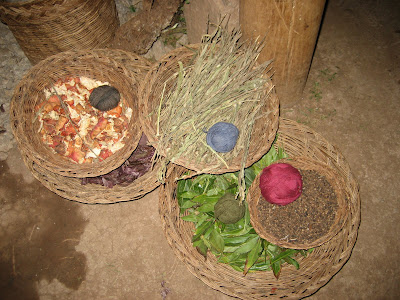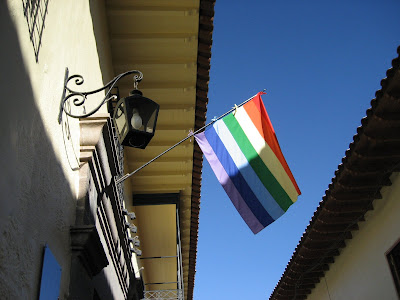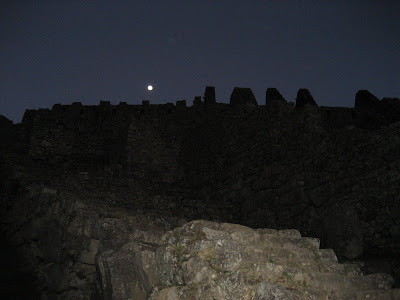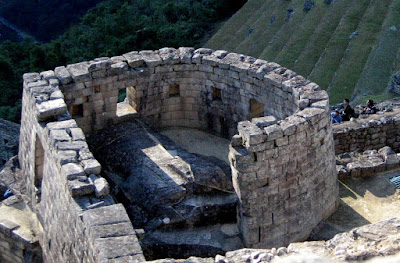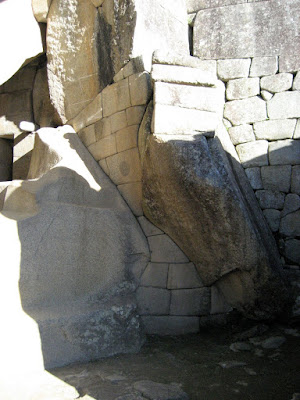Travels With Kerri
"Not All Who Wander Are Lost"
31 July, 2008
25 July, 2008
24 July, 2008
Secret Mountain Trail
From Flagstaff, I took a long dirt road for many miles to find the remote trailhead. There were lots of deer, and I even saw a javelina.
The trail led to this old cabin which was used first as a ranch house and then as a hideout for Mormom polygamists. There were some old corrals and a little pond.
It led to the top of the Mogollian Rim with nice view of Sedona. This is the view from my tent.
23 July, 2008
Sycamore Canyon
This 12 mile long loop has 5 trailheads, but I chose to start near KA Hill and headed clockwise. This trail is diverse and holds lots of surprises along the way.
This pretty lily-filled pond was near Dow Spring.
This is a typical view of Sycamore Canyon.
I camped on the edge of the cliff and listened to the birds and coyotes. There was also a pretty killer echo, so I spent some time hollering over the edge.
Sycamore Rim Loop
The forest was sort of a transition zone. I kept finding small cacti and beautiful blooming agaves.
This is near the dry waterfall area; it's popular with rock climbers.
My favorite area was Pomeroy Tanks, a natural and permanent water reservoir which many of the animals in the area rely upon. As I walked along the edge of the ponds, little frogs would hop into the water. It was quiet and idyllic, and we had the place to ourselves.
22 July, 2008
Bull Pass Loop
Kendrick Mountain is oddly shaped with a wide flat mesa and a tiny triangle peak on top.
Tahoe and I embarked on this 13.5 mile journey in a slight rain. I kept hoping it wouldn't pour until we were at the top.
Surprisingly, the skies cleared, and we were able to enjoy a nice ramble through Bull Pass Valley. Most of the mountain was devastated during the Pumpkin Fire of 2000, but the grass, bushes, and wildflowers are grown back.
We heard some elk late at night.
Kendrick Peak
Near the cabin and lookout tower, the trees were untouched by the fire. They probably dumped loads of flame retardant to save those structures. The aspen trees and douglas fir were tall and majestic.
There is an old ranger's cabin a half mile from the summit. It was built in the early 1900's, but has been out of official use for a long time. It is unlocked, and visitors are welcome to stay the night.
There were 3 beds, a table, and a metal chest with a tarp and some other supplies. It was nice, but I decided that I would rather sleep under the stars since it was such a warm night, about 50 degrees.
Kendrick Peak is the 8th highest peak in Arizona at 10,400 feet. The views from the top were stunning. I could see many old volcano craters like this one dotting the countryside.
14 July, 2008
Inti Raymi
I went to the Inti Raymi festival on June 24th. It is the biggest celebration in Cuzco. Hundreds of people dressed up in costumes to perform a play at Sacsaywayman, some Inca ruins. This event happens every year. The same play is performed. This year though, things were different. Instead of opening both hills for people to watch the play for free, they only opened one. 20,000 people show up for this thing every year, and it is a huge event. People bring their entire families and spend the day out there, picnicing, talking, and selling stuff.
This turn of events was not accepted by the locals. The people rioted. About 20 minutes into the play, a small group of young people threw rocks at the police and broke thorugh the police line. The cops tried to hold them back.
But, then, everyone started running up the hill. It was crazy. There weren't enough police to do anything about it. Everyone on our hill cheered their victory.
Within 5 minutes, the hill looked like this. I wonder if they'll try to close that hill next year?
13 July, 2008
Pisac
We took a day trip around the Sacred Valley.
Set high above the Urubamba Valley, the Pisac citadel is home to some magnificent ruins.
The Sacred Valley is made upo of 3 cities that are all on the edge of the Urubabma Valley. The Incas created these towns and the roads between them. As the crow flies, the 3 towns are exactly 30 kilomenters apart, like a triangle. No one knows how the Incas were able to do that. (I sure hope I meet some Incas in heaven. I have so many questions!)
Ollantaytambo
We climbed about 300 steps to get to the top of the fortress. Ollantaytambo is one of the most important astronomical sites in all of Peru.
The Incas carved the profile of a king's head into the rock mountain. (Look in the center of the picture on left of mountain.) It is also a Puma head. (See the 2 jagged rocks sticking out of the mountain, just above the head, those are the puma's ears, and the king's head is the puma snout.) At summer solstice, the sun emerges just where the kings eyes are.
This is the mysterious Princess spring. The young Inca girls would be required to pass their hand over the water, and if it stopped flowing, then everyone could tell that they were a virgin. Our guide showed us, and it actually worked. The water did stop! So, that means, either he was a virgin, or there is some mysterious physics principle at work there.
Although Peruvians are becoming more modern thinkers, they are also strongly influenced by their traditions. For example, many houses have small crosses on top; that indicates the occupants are Catholic. However, they also have an object next to the cross, like cattle. That is a good luck charm which they hope with bring them luck in that particular area.
12 July, 2008
11 July, 2008
Inti Raymi Week
Cusco's flag is a rainbow.
All week during the winter solstice, the people celebrate in the streets. There are parades, music, food, and dancing.At night, the atmosphere rivals Mardi Gras in New Orleans. Party-goers were up all night in the streets, wearing costumes, drinking beer, and really letting loose.
10 July, 2008
Machu Picchu
We arrived at Machu Picchu on the winter solstice. We were the first to arrive at the ruins, and Rauol knew exactly where to take us; we literally had the best seat in the house. After about an hour, the place was crawling with people toting cameras with huge telephoto lenses.
Just before the sun rose, we waited in quiet anticipation of the amazing event. It is incredible to think that all this was built in 1450 by people who did not have horses, the wheel, or a written language.
The sun rose over the eastern mountain.Then, the sun rays shone directly though the window on the Sun Temple. It only happens once a year, so I was thrilled to be able to see it.
Holy Sites
 This large stone is called Intiwatana. It held religious and astronomical significance. The four corners point exactly to north, west, east, and south.
This large stone is called Intiwatana. It held religious and astronomical significance. The four corners point exactly to north, west, east, and south. The Temple of Three Windows was impressive. It's a mystery as to how they got the giant boulders up there.
The Temple of Three Windows was impressive. It's a mystery as to how they got the giant boulders up there. This is the front of the Sun Temple and the window in which the sun rays shone through. There are two hawks flying above the temple. Rauol said that was an auspicious sign.
The Temple of the Condor was shaped like Condor wings. It was probably used as a torture chamber. There is a pit in the floor for blood to flow down. The Condor was a symbol for justice.
Here's another view of the Sun Temple and surrounding holy buildings such as the Temple of Three Windows, Royal Palace, and the Sacristy.
